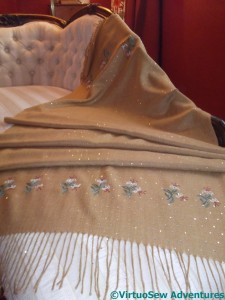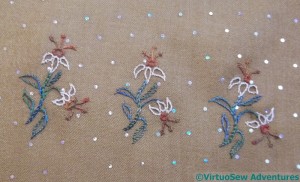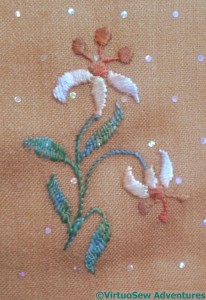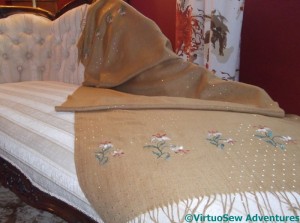The Great Lady’s Magazine Stitch-Off – 3
If I were writing a report card for myself, I would write: Rachel has made a good attempt, but continued application is required to produce excellence.
Finally, after much muttering, wrangling, and stitching, I have finished the pashmina I decided to embellish as a part of the Great Lady’s Magazine Stitch-Off. I’ve washed it (carefully, by hand) and pressed it (carefully, on a cool wool setting) and photographed it draped over my parents’ settee, which isn’t the right period, but does make a lovely backdrop..
Time alone will tell whether it is a practical piece that I enjoy wearing and don’t spend all my time repairing, but for now I am pleased. Although I must admit, rather more of the little paillettes flew off in the course of the stitching than I was expecting. It will only be dotty in patches!
One end has a row of motifs, all the same size, and worked purely in outline. Primarily I have used stem stitch, although split stitch and chain stitch both make an appearance, too.
The small motifs were fairly quick to stitch, and didn’t require much self-discipline because I could see the progress I was making. I’m not good at repeated motifs – I lose interest quickly – so this was very good news.
At the other end, the motifs are larger – in two different sizes in fact, two larger ones interspersed with three slightly smaller.
The larger motifs used a wider combination of stitches. Stem stitch for the stems – naturally! Satin stitch for the petals, worked over a split stitch outline, and using three strands of the stranded silk thread instead of two. It might have been better to use four, in terms of the coverage, but that would entail larger holes in the fabric, and I wasn’t willing to do that.
The leaves are worked in Romanian Couching, using the couching stitch to create a vein up the centre. Since the green thread is an unspun, indeed untwisted floss silk, it spread nicely. It has also got a mind of its own and unstitches itself unless finished off with great thoroughness.
One of the reasons the researchers wanted to extend the stitch-off project was to see whether they would gain any insights from it into the lives and work of the readers of The Lady’s Magazine. One thing I’m sure they will be reminded of anew is that the designs may be the same, but the treatments so different as to render them almost unrelated in appearance.
As I said in my earlier post, I have a renewed respect for any lady who embroidered her own silks and muslins, but I should also highlight something I believe we are inclined to forget. I’m sure the general standard of embroidery was good – it was an expected accomplishment, after all, – but I don’t believe it was all as breathtakingly exquisite as what we see in some surviving pieces.
Textiles were extremely valuable until quite recently. They were reused, altered, left as bequests. The pieces that remain are either fortunate accidents of history (a forgotten trunk in an attic, say) or they were so remarkable as to be treasured. Embroidery worked at home for a day dress or other garment would have been worked quickly so that it could be worn, and in due course the dress cut down into something else, and finally, no doubt, sent for rags. The little aprons which protected expensive wool and silk dresses had to survive the washing of the day – pounding in a tub of boiling water – and again, when they could no longer be made respectable, became cleaning rags.
I wrote an entire post about transferring designs, but again, drawing was an expected and widespread skill. Many of the readers may have simply copied the design freehand onto their fabric, unconcerned about pinpoint accuracy, aiming only to provide an approximate guide for their needle. These are skills no longer as widespread, and we trust ourselves less than they would have done.
This isn’t evidence of one of my finest hours, but it is a perfectly competent piece of work, perhaps in the traditions I have just described, of work done quickly for a particular occasion or event. I am going to send it to Chawton House as a contribution to their exhibition celebrating the 200th anniversary of the publication of Jane Austen’s “Emma”.





Dear Rachel, this is stunning work! And it’s going to look just beautiful in the Oak Room as part of our #EmmaAt200 exhibition. Thank you so much for sending it to us.
Gillian
It looks rather splendid. I expect you will wear it more frequently than you expect. And be followed by a train of admirers, amid the gentle patter of falling sequins.
Absolutely with you on dress embroidery only needing to be ‘good enough’. One of the downsides of our lovely modern macro photography is that we see work in far more detail than we see it in reality. (This is particularly true for evening wear, when the lighting was oil lamps or candles.) We also look at things dead-on, rather than at an angle and in motion.
I found that the sprigs (which I tried out in shadow work) were just the right size for one comfortable stitching session, making a morning’s progress very obvious. (My own little sprig is already on its way to Chawton, Rachel, so it looks like our stitching will meet up before we do!)
It looks wonderful. I love the fact that you stitched it on something that you will actually be able to wear.
I think this looks so pretty – very delicate and precise. I’d use it any day! Well done.
I think it’s lovely. And it’s far better than a lot of embroidery out there, and no one will be looking at it too closely. I can just see someone sticking her nose down among the end of pashmina to examine the embroidery.
Beautiful. If you send it for the Chawton House exhibit, it will be returned, right?
I think it’s rather gorgeous, and very well done!
It looks lovely, and will look quite at home in Chawton House (we used to live in Hampshire, so I have visited the house several times).
When I was little, my sister and I cut up pieces of embroidery and crochet lace done by our Granny and Great Aunt, to make clothes for our dolls!
Wow – it looks amazing! And it’s also quite large.
The stitching looks lovely and i like the sparkle from the dots. That’s an interesting point about only the best embroidery work surviving
Hmmm! ‘competent’? Your ‘competent’ would be my masterpiece. This is beautiful and probably not all that easy to work on and yet your stitching is lovely. How sad, the story of lost embroidery. What I wouldn’t give for only a scrap of something stitched so very long ago.
It looks wonderful draped over the sofa, Rachel. It has never occurred to me to buy a pashmina with the aim of embroidering it. Don’t know why… but having seen this I now think maybe I should give it a go.
Your observations on embroidery of the past are interesting and I’m sure you’re right. We only see the best of what they did, and the most treasured and most safely stored away.
Lovely to send it to the Jane Austen exhibition.
I am very envious that you have finished this piece. It suits the pashmina and I think you are going to get a lot more use from it than you might now think. Any thoughts to whom you will pass it on to? It could become one of those pieces you were talking about.
Giggling at your report card – what a slave driver! I think the insights it’s given you into the stitchery process in those days are fascinating. A little bit of experimental history perhaps?
if I was writing your report card it would read ”Rachel continues to demonstrate excellence in all she does. If Rachel would like an A for every assignment this year all that is required is for her to gift me this beauty!!”.
I can’t make any educated comments about this, but I know what I like, and I do like what you did with these stitches. The photo on the settee is lovely, too. I’m glad it will get some exhibition at the Emma venue. It deserves to be seen and admired. =)